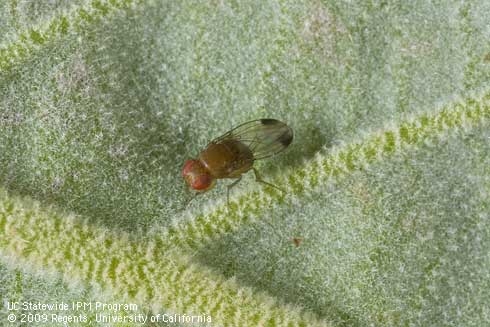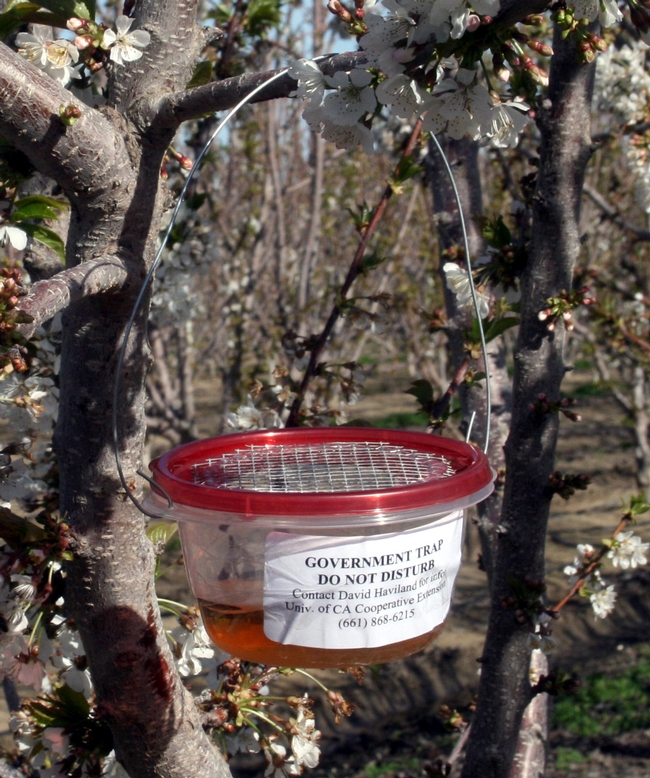
Posts Tagged: Cherries
Warmer winter is hurting California cherry crop
The drought isn't helping matters, but the primary concern for cherry farmers in California is the lack of winter chill, reported Lisa Morehouse on KQED's The California Report.
Morehouse spoke to Bill Coates, a UC Agriculture and Natural Resources expert based at the UC Cooperative Extension office in San Benito County. He said cherries are more sensitive than other crops to a lack of chill hours. Because of a warming weather trend during the winter, bing cherry trees look confused about what season it is.
“You have some ripe cherries, you have some blossoms, some branches that are almost devoid of leaves, and you have some buds that are still dormant,” he explains. “And this is all a result of lack of chilling.”
Bing cherries need about 1,000 hours under 45 degrees for healthy dormancy. Last year San Benito County got just over 500 hours.
"People may disagree on the cause of the change," Coates says, "but there definitely has been a change in the climate, and it's going to impact tree crops greatly."
Be on the lookout for spotted wing drosophila

Unlike other fruit flies that infest rotted fruit, SWD attacks undamaged fruit. As cherry fruit begins to develop and starts to change color from light green to straw, SWD lays its eggs just under the skin of fruit, creating a small scar or a“sting.” One to three larvae may develop inside each cherry, feeding on the fruit and causing it to become brown and soft. Many times SWD flies are not noticed until fruit is mature, and by that time management is not very effective.

Spotted wing drosophila is still a relatively new pest, and management information continues to change. David Haviland, UC Cooperative Extension advisor in Kern County, and other researchers have been working to provide what help they can. Haviland has designed a bucket trap called the “Haviland trap” and is working with others to field-test experimental lures for SWD. He's also studying a possible biological control agent. Research has led to new grower guidelines so that early season cherries can be produced and sold internationally. Check out the 2014 Recommendations for Sweet Cherry (PDF).
For management in backyard cherries or other urban areas, see the SWD Pest Note.
For more information about UC IPM's recent work, see the 2013 Annual Report.
California cherry crop 'unusually light'

Joe Grant, UC Cooperative Extension advisor in San Joaquin County, said the cherry crop is light throughout the area, across orchards and varieties.
"That rules out orchard-to-orchard factors, management factors or disease factors," he said.
Crop losses are often weather-related, but early frosts, or wet or cold weather during the bloom were not factors.
"Right now, the only candidate ... is we had quite warm weather for a couple of days during bloom," Grant said. That heat may have affected pollination and reduced the amount of fruit each tree carries.
On the bright side, the fruit looks to be of good quality.
Farmers turning in greater numbers to mechanical harvesting

Some cherry growers, for example, were able to pick only once this year, said Chuck Ingels, UC Cooperative Extension advisor in Sacramento County. Ideally, they'd pick as fruit colors and ripens.
"They're finding that if they can't get labor to pick their crops, they're just not able to farm anymore," Ingels said. "So what they're going to is mechanization."
UC Davis agriculture experts, farmers and industry leaders gathered last month in Orland to watch a demonstration of the first mechanical harvest of Manzanilla table olives in California. The new technology could revive the industry, the article said.
Even pear harvesting, a grueling job that requires workers to climb aluminum ladders with heavy bags of fruit, may be ripe for new harvest technology. For apples and pears, there are platforms for workers to stand on that move through the orchard while the workers feed the fruit into flexible tubes, where suction carries the fruit to bins.
"It's definitely on the radar for growers in the industry," Ingels said.
Reasons for the seasons

California residents not only enjoy an enviable climate and diverse regions, but also a wide selection of fresh produce year around.
As consumers, we want to stretch our food budget and provide a nutritious diet to our families; but we are not always sure about how to select the best fruits and vegetables, how to store them when we get home, new ways to serve them, and the nutrition benefits they offer.
Placer-Nevada Cooperative Extension has come to the rescue! As part of the Nutrition Best program, UCCE nutrition educators have prepared "Reasons for the Seasons - Produce tips for Placer County consumers," a series of seasonal produce handouts that provide practical information for families and children on purchasing, storing, preparing and serving locally grown seasonal produce.
Each handout also includes tips for families on the importance of family meals and snacks, a couple of tasty and easy-to-prepare recipes, and a coloring page for the children.

News & Information Outreach in Spanish has started to adapt into Spanish these handouts, and produced short video clips. The first one is for strawberries.
To tickle your interest, here is a sampling of some of the tips and information you'll find:
Apples – Over 7,000 varieties have been identified, however most consumers are only familiar with half a dozen or so varieties. Munching on an apple is a tooth cleaner and a gum stimulator. Apples may last up to three months if stored correctly.
Broccoli – Its name comes from the Latin word Brachium which means "branch" or "arm." Broccoli is one of the most nutritious vegetables you can eat. Instead of loading it with a cream sauce that is high in fat, try serving it with silvered almonds, sesame seeds, toasted bread crumbs or parmesan cheese. The leaves can also be eaten and contain more beta carotene than the florets. Store broccoli in an open plastic bag in the refrigerator vegetable drawer. For boiling or steaming, use a non-aluminum pot or pan. Aluminum seems to increase broccoli's cooking odors.
Cherries – Cherries are among the best foods for a snack. The riper the cherry, the larger the size, the deeper the color and the sweeter the fruit. Sour cherries are lower in calories and higher in vitamin C and beta carotene than sweet cherries. You can extend the cherry season by freezing them. They will keep for up to a year in your freezer.
Tomatoes - Botanically, tomatoes are a fruit. This is because, generally, a fruit is the edible part of the plant that contains the seeds, while a vegetable is the edible stems, leaves and roots of the plants. Tomatoes are the leading source of vitamin C in the American diet because of the quantities we eat. Store tomatoes at room temperature for up to one week; longer if still ripening.
Potatoes - Keep the potatoes in a burlap or a brown paper bag. Do not store onions with potatoes. The gases given off by onions accelerate the decay of potatoes and vice versa.
Melons – Most melons originated in the Near East. They are a good source of vitamin A, C and potassium. Serve melons slightly chilled; if they are too cold, you'll miss their full fragrance. Ripe melons are very fragrant, and the aroma of a cut melon can penetrate and effect other foods
Cauliflower – A good source of vitamin C, potassium and fiber. It has been associated with reducing the risk of cancer. Cauliflower should not be cooked in an aluminum or iron pot. It will turn yellow if cooked in an aluminum pot, and blue-green or brown if cooked in an iron pot.
Beets – Beets come in a glistening array of color, from garnet red, to red-white striped, to deep gold, to creamy white. The entire beet, from its robust and flavorful root to its buttery green top, is sweet and delicious. To maintain firmness, cut off beet greens before storing, but leave at least an inch of the stem attached.
May and June are cherry season, so why not look for new ways to enjoy this delicious and nutritious fruit?
Cherry salsa

1- 1/3 cups tart cherries, frozen
1/4 cup red onion, finely chopped
1 tablespoon jalapeños, diced
1 clove garlic, peeled and chopped
1 tablespoon fresh cilantro, chopped
1 teaspoon cornstarch
Coarsely chop cherries. Let cherries thaw and drain, reserving 1 tablespoon cherry juice. When cherries are thawed, combine drained cherries dried cherries, onion, jalapenos, garlic, and cilantro in a medium saucepan; mix well. Combine reserved cherry juice and cornstarch in a small bowl; mix until smooth. Stir into cherry mixture. Cook, stirring constantly, over medium-high heat until mixture is thickened. Let cool. Serve with tortilla chips.
This recipe can also be served over cooked chicken or pork
Southwestern-style cherry slaw
Yield: 6 -8 servings
Slaw:
4 cups shredded green cabbage
3 cups sweet cherries, pitted and halved
2 cups torn fresh spinach leaves
1 cup shredded jicama (optional)
1 cup shredded carrot
1/2 cup snipped fresh cilantro
1/2 cup diced red onion
1 avocado, peeled and diced
Toasted pine nuts for garnish
Dressing:
2 tablespoons olive oil
2 tablespoons fresh lime juice
2 tablespoons frozen lime juice concentrate, thawed
1 jalapeno pepper, seeded and minced
1/2 teaspoon lime zest
1/4 teaspoon each chili powder, ground cumin and salt
In large serving bowl, combine ingredients for Slaw. In small saucepan, combine Dressing ingredients; heat to boil. Pour over salad and toss gently to coat. Garnish with pine nuts and serve.
Recipe: Northwest Cherries Online


